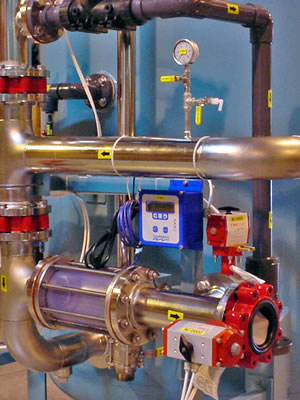MBD-Series Mixed Bed Demineralizer System
Mix Bed Demineralizers are one of the most effective methods available to remove dissolved impurities from water for high purity applications.
The regeneration cycle consists of three stages: a preliminary backwash, an ion-exchange regeneration, and a two-stage rinse. During the backwash stage, an upward flow of water enters the bottom of the vessel loosening the resin bed and flushing away any suspended particles. The backwash usually lasts about 10 minutes.
To regenerate the resin, a solution of regenerant chemicals is passed through the resin in a downward direction, generally sulfuric acid for the cation resin and sodium hydroxide for the anion resin. The regenerate chemicals react with the demineralized ions on the resin, causing them to precipitate out of solution, and restoring the resin to its original state. To insure regeneration integrity, introduction of the acid and caustic regenerant solutions must be carefully engineered using pressure and blocking techniques to insure that they enter above and exit below the appropriate resin bed layer.
When regeneration is complete, the resin is rinsed to remove any precipitated compounds and to displace spent chemicals from the resin. First, with a slow down flow through the resin bed to displace the spent chemicals and precipitates, followed by a fast down flow, or purge, to flush all of the remaining chemicals from the vessel. All spent chemicals must be captured and neutralized to comply with State and Federal disposal regulations.
All demineralizer vessels are ASME Code designed and stamped. Materials of construction can be either composite, steel, or alloy. Manways and handholes are sized to suit the internals and service. Steel vessels are epoxy lined and painted with structural steel legs.
Standard internals and face piping are schedule 80 PVC, but can be available in other materials. The inlet distributor consists of either a hub or header with drilled laterals; the outlet collector consists of a hub or header with slotted laterals. The selection of a hub or header arrangement is dependent upon the size of the filter vessel. Both internal and face piping are factory supported.
Standard valving is pneumatically actuated. For line sizes 2" and smaller, ball valves are utilized; in larger line sizes, butterfly valves.
A PLC Controller to automate the backwash, rinse, and in service cycles is standard with the unit. The system is completely factory assembled and tested.
- Automation Delete
- Stainless Steel or Alloy Piping
- Stainless Steel or Alloy Internals
- Custom Instrumentation
- Alternate Backwash Source
- Valve Upgrades
- Sight Glasses
- Resin Trap
- Manway Options
- Lining Options
- Paint Options
- Relief Valve
- Auto Sanitization
- Regenerant System
- Recirculation System
- High Purity Configuration
